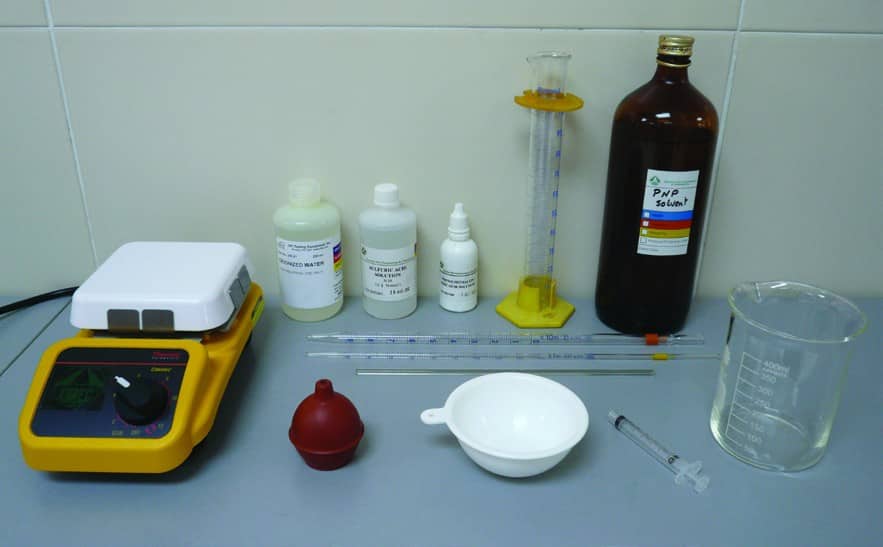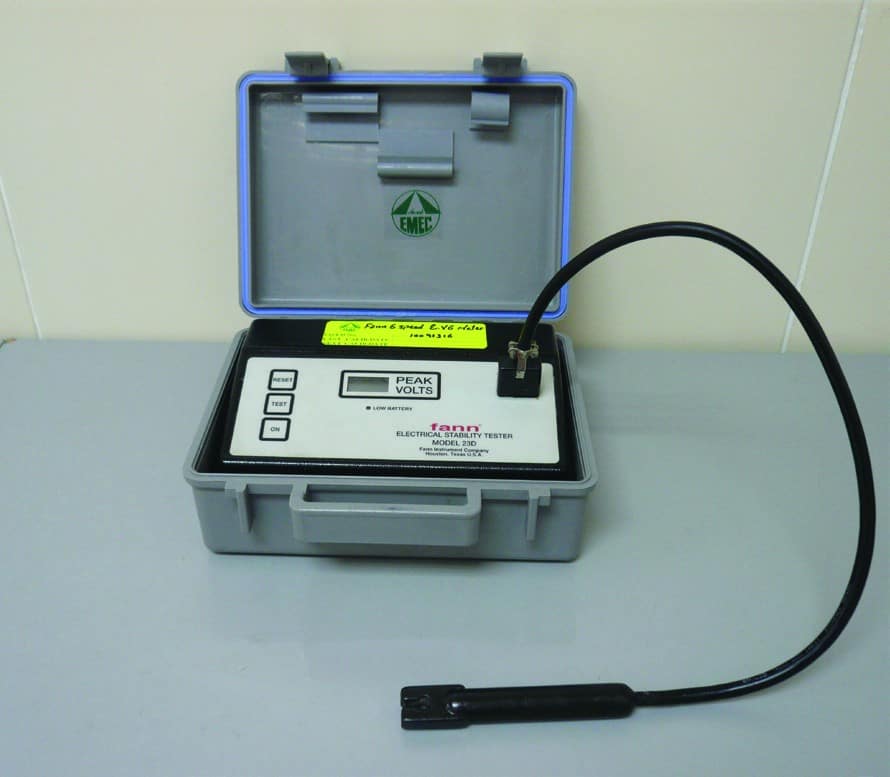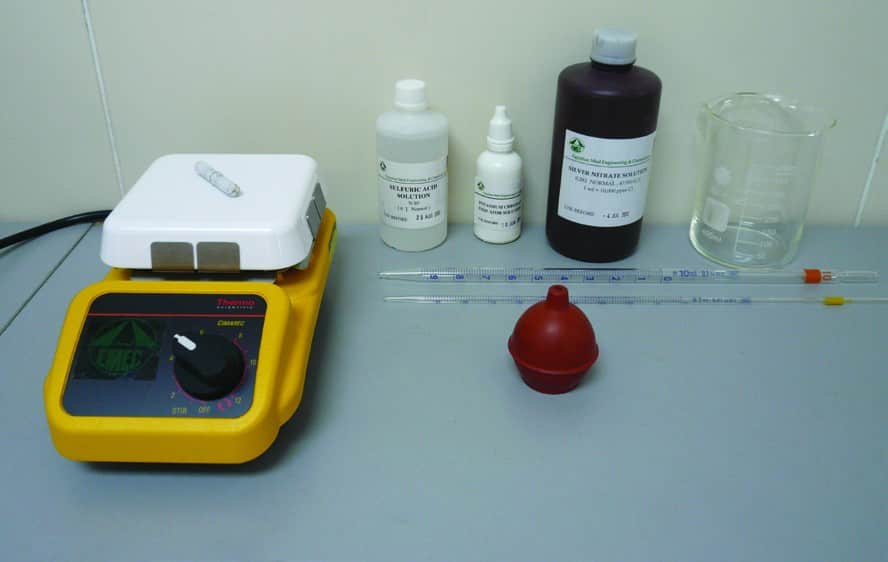This article will introduce a complete guide for the oil-based mud testing procedures, including physical and chemical tests. This article is part of the significant article on drilling fluid test procedures.
Oil-Based Mud Testing Procedures For Physical Properties
These Oil Based Mud Testing Procedures For Physical Properties are as follows:
- Oil-Based Mud Testing Procedures For Mud Density
- Rehometer | Viscometer OBM Testing Procedures
- Oil-Based Mud API Filter Press Testing Procedures
- HPHT Filter Press OBM Testing Procedures
- Sand Content In OBM Test Procedure
- Retort Analysis For Oil Based Mud
Oil Base Mud Whole Mud Alkalinity and Lime Content Testing
Whole Mud Alkalinity and Lime Content Alkaline products help to stabilize oil-water emulsions, and they also neutralize acidic gases that may be encountered while drilling (e.g., CO2 and H2S), which is why Oil Based Mud is formulated with Lime. The Whole Mud Alkalinity test is a titration method for measuring the amount of Lime in the oil-based mud (i.e., Excess Lime).

The test requires the following equipment:
- Propylene Glycol Normal Propyl Ether (PNP) solvent
- 400 ml glass beaker
- Graduated measuring cylinder (100 ml)
- 5 ml syringe
- De-Ionized Water
- Phenolphthalein indicator solution
- Sulfuric Acid (0.1N solution)
- Sodium Hydroxide (0.1N solution)
- 1 ml graduated pipette
- 10 ml graduated pipette
- Magnetic Stirrer with plastic-coated stirrer bar
The titration procedure for determining alkalinity in OBM requires 100 ml PNP solvent. This solvent will consume a small amount of alkalinity, known as the Base Alkalinity Demand (BAD). The BAD can be determined and added to the alkalinity measurement for the OBM to represent the alkalinity/lime content accurately.
Oil Based Mud Testing Procedures For Whole Mud Alkalinity are as follows:
Base Alkalinity Demand
- Use a graduated measuring cylinder to transfer 100 ml Propylene Glycol Normal Propyl Ether (PNP) solvent into the 400 ml glass beaker.
- Add 200 ml de-ionized water and 15 drops of phenolphthalein indicator solution and mix using the magnetic stirrer.
- Titrate immediately with 0.1N NaOH solution while stirring until a pink color appears.
- Continue stirring for 5 minutes. If the pink color remains, the endpoint has been reached. If the pink color disappears, then continue the titration by repeating Step 3. The Base Alkalinity Demand (BAD) can be calculated from the 0.1 N sodium hydroxide volume used in the titration, as shown in Figure 15 below.
Whole Mud Alkalinity
- A graduated measuring cylinder transfers 100 ml Propylene Glycol Normal Propyl Ether (PNP) solvent into the 400 ml glass beaker.
- Fill the 5 ml syringe with a sample of oil-based mud, ensuring it contains no bubbles, and displace 2 ml of this mud into the 400 ml glass beaker.
- Swirl the contents of the glass beaker until the oil-based mud and solvent is homogeneous.
- Add 200 ml de-ionized water to the glass beaker and add 15 drops of phenolphthalein indicator solution (Alkalinity from the Lime will turn the solution pink)
- Place the plastic-coated stirrer bar in the beaker, place the beaker on the magnetic stirrer, and adjust the speed to stir the contents rapidly.
- Use a 1 ml or 10 ml pipette to carefully titrate the fluid in the glass beaker with 0.1N sulfuric acid until the pink color disappears.
- Continue stirring the fluid for one minute, then stop stirring and leave the fluid to stand for five minutes. Continue titrating with 0.1N sulfuric acid if a pink color reappears. Otherwise, the endpoint has been reached.
The calculation for determining Base Alkalinity Demand.
Base Alkalinity Demand (BAD) = ml of NaOH (0.1N) solution
- The Whole Mud Alkalinity can be calculated from the volume of 0.1N sulfuric acid used in the titration (ml).
Calculations for determining Whole Mud Alkalinity and Lime Content.
Whole Mud Alkalinity = (ml 0.1N sulfuric acid used + (BAD)) / ( Mud sample volume (ml))
Whole Mud Alkalinity = (ml 0.1N sulfuric acid used + (BAD)) / 2ml
Lime Content (lb/bbl) = 1.295 x whole mud Alkalinity
Electrical Stability Test (EST) Procedures
OBM Electrical Stability Definition
The Electrical Stability test of oil-based mud ( you may also be interested in THE 9 MAJOR BENEFITS OF OIL BASED MUD OVER WATER BASED FLUID) is a measure of the strength of the oil/water emulsion.
Please note that this article is a part of our Full Guide For Drilling Fluid Testing Procedures.
Oil-Based Mud Testing Procedures For Electrical Stability Tester Mechanism
The Electrical Stability test Meter is a battery-powered device with a digital voltage display. Also, It is connected to a probe that contains two flat-plate electrodes a fixed distance apart.
The probe is immersed in the oil-based mud sample, and a voltage is applied to the electrodes on the probe. The voltage automatically increases until it is high enough to break down the oil/water emulsion.
A weak emulsion will break down with a relatively low voltage across the electrodes, but a strong emulsion will require a much higher voltage before breaking down. The voltage required to break down the emulsion appears on the digital voltage display. Always measure the Electrical Stability at 120°F (50°C) using the rheometer heating cup before or after taking the rheometer readings.
Oil-Based Mud Testing Procedures for Measuring Electrical Stability Test:

- Fill the rheometer heating cup with oil-based mud screened through a Marsh Funnel.
- Check that the gap between the ES probe electrodes is clean and dry, and stir the mud with the ES probe until the mud sample temperature is uniform at 120°F (50°C)
- Hold the probe steady in the mud sample, and also make sure the probe does not touch the side or bottom of the heating cup.
- Start the voltage ramp test until the digital voltage reading becomes steady, giving the mud’s Electrical Stability (ES) (peak volts).
- Stir the same mud sample with the ES probe and confirm the ES reading by repeating the measuring procedure in Steps 3 and 4 (both ES readings should be within 5% of each other). The ES meter and probe may be faulty if the difference between the two ES readings is more significant than 5%.
- You should always report the average of the two ES measurements.
- Clean the ES probe and check that the gap between the electrodes is clean and dry for future use.
Mud Engineers usually maintain an Electrical Stability Test above +/- 300 volts. The ES may drop if the mud has been static for an extended period (i.e., during round trips – check also tripping pipe procedures), but it usually recovers once circulation resumes and the mud has been sheared through the bit, which restores the quality of the emulsion. You can improve ES readings by adding emulsifiers to improve the oil/ water emulsion.
Related Papers
If you cannot purchase such a document, you can use SCI-Hub Services.
- Electrical Stability, Emulsion Stability, and Wettability of Invert Oil-Based Muds
- Improving drilling performance with continuous online measurements of electrical stability and conductivity in oil-based drilling fluids
Whole Mud Calcium Content For Oil Base Mud
The test for whole mud chlorides may help determine water phase salinity, but it does not distinguish between sodium and calcium chloride in the brine phase. Whole mud calcium content is a titration method for measuring calcium concentration in the oil-based drilling mud, which enables the calcium chloride concentration in the brine phase to be calculated. Calcium in the mud will come from calcium chloride and lime (calcium hydroxide) used in the formulation but may also come from gypsum or anhydrite (calcium sulfate) formation.
Equipment used for measuring Whole Mud Calcium Content.

The test requires the following equipment:
- Propylene Glycol Normal Propyl Ether(PNP) solvent
- 500 ml glass conical flask with stopper
- Graduated measuring cylinder (100 ml)
- 5 ml syringe
- De-Ionized Water
- Sodium Hydroxide buffer solution (1N)
- Calver II indicator powder
- 1 ml graduated pipette
- 10 ml graduated pipette
- EDTA reagent (0.1M)
- Magnetic Stirrer with a plastic-coated stirrer bar. Now, let’s move to the whole mud calcium content procedure.
The API Procedure
- A graduated measuring cylinder transfers 100 ml Propylene Glycol Normal Propyl Ether (PNP) solvent into a 500 ml conical flask.
- Fill the 5 ml syringe with a sample of oil-based mud, ensuring it contains no bubbles, and transfer 2 ml into the conical flask.
- Place the stopper on the conical flask and shake vigorously until the mixture is homogenous.
- Add 200 ml de-ionized water to the conical flask.
- Add 6 ml 1N Sodium Hydroxide buffer solution to the conical flask.
- Add Calver II indicator powder to the conical flask.
- Place the stopper on the conical flask and shake vigorously for two minutes.
- The presence of calcium will produce a red coloration in the lower aqueous phase as the oil and water separate out to form two layers.
- Place the plastic-coated stirrer bar in the conical flask on the magnetic stirrer, and adjust the speed to stir the contents without mixing the oil and aqueous phases.
- Use a 1 ml or 10 ml pipette to carefully titrate the water phase in the conical flask with 0.1M EDTA until the color of the fluid changes from red to blue-green.
- The Whole Mud Calcium Content can be calculated from the volume of EDTA used in the titration (ml). See Figure 18 below.
Whole Mud Calcium = 4,000 x ml 0.1M EDTA / Mud Sample Volume (ml) 4,000 x ml 0.1M EDTA 2 ml
Whole Mud Chloride Content For Oil Base Mud
An oil-based mud‘s water or brine phase usually comprises calcium or sodium chloride brine, with salinity adjusted so that the Water Activity (Aw) of the brine matches that of the fluid trapped in the shale pores. Suppose the water activity of the oil-based mud brine phase is too high or too low relative to formation fluids. In that case, fluid will naturally move into or out of the formation until the water activity is equalized. A shale formation may therefore be subject to hydration or dehydration (check also Shale Inhibitors), and potential wellbore instability, if there is a significant mismatch in water phase salinity. The aim while drilling is to maintain balanced activity. This article aims to teach you the procedures for the whole mud chloride content test for oil-based mud.
Equipment Required For Whole Mud Chloride Content For OBM

The Whole Mud Chloride Content is usually measured with the same fluid sample after measuring Whole Mud Alkalinity. The procedure is similar to the silver nitrate titration method used on water-based fluids to precipitate out silver chloride. As with the water-based procedure, the titration must be performed under acidic conditions. The additional equipment required for such a test is as follows:
- Potassium Chromate indicator solution
- Silver Nitrate reagent (0.282 N)
- Sulfuric Acid (0.1N solution)
- 1 ml graduated pipette
- 10 ml graduated pipette
The procedure for measuring Whole Mud Chloride Content For Oil Based Mud
- Ensure the sample to be titrated for chlorides is acidic (below pH 7.0) by adding 10 to 20 drops of 0.1N sulfuric acid to the same sample used for the Alkalinity test.
- Add 10 to 15 drops of Potassium Chromate indicator. Adjust the magnetic stirrer’s speed so that the glass beaker’s contents are stirred rapidly.
- Use a 1 ml or 10 ml pipette to carefully titrate the fluid in the glass beaker with 0.282N Silver Nitrate reagent until the fluid turns salmon-pink and remains stable for at least one minute.
- The content can be calculated from the volume of 0.282N Silver Nitrate used in the titration (ml).
Whole Mud Chloride Content (mg/I) = 10,000 x ml 0.282N Solver Nitrate / Mud Sample Volume (usually 2ml)
The Whole Mud Chlorides can be attributed to the brine phase as long as the brine phase is below the saturation point. The Water Phase Salinity is important for shale inhibition. Also, for calculating corrected solids from the retort (Check also retort analysis for drilling fluid) results since the “solids” reading from the retort will include the dissolved salts in the brine phase.
Assalamu Alaikum, can the Chloride test of the whole mud be done on a different / new 2 mg of whole mud, and not the sample previously used to check the alkalinities? if not why? I am interested in the colloid chemistry of the drilling mud and how the possible change of the overall chemical valences can be changed to increase or retard the viscosity, i.e. by electrical and not mechanical means. Please reply ASAP. Thank you.